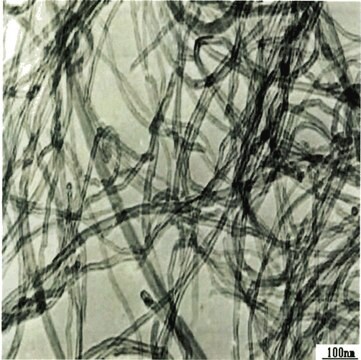Kluczowe dokumenty
750522
Carbon nanotube, single-walled
98% (Semiconducting), avg. no. of layers, 1
Synonim(y):
IsoNanotubes-S™, SWCNT, semiconducting, SWCNT, SWNT, Single wall carbon nanotube
About This Item
Polecane produkty
Poziom jakości
Próba
2% (Metallic)
98% (Semiconducting)
Formularz
solid
Właściwości
avg. no. of layers 1
producent / nazwa handlowa
NanoIntegris, Inc.
Długość
0.3-5 μm
średnica
1.2-1.7 nm
mp
3652-3697 °C (lit.)
gęstość
1.7-1.9 g/cm3 at 25 °C (lit.)
ciąg SMILES
[C]
Klucz InChI
OKTJSMMVPCPJKN-UHFFFAOYSA-N
Szukasz podobnych produktów? Odwiedź Przewodnik dotyczący porównywania produktów
Opis ogólny
Zastosowanie
- Electronics
- Sensors
- Composites
- Energy Storage
- Study of Life Science systems
Uwaga dotycząca przygotowania
Informacje prawne
Kod klasy składowania
11 - Combustible Solids
Klasa zagrożenia wodnego (WGK)
WGK 3
Temperatura zapłonu (°F)
Not applicable
Temperatura zapłonu (°C)
Not applicable
Wykazy regulacyjne
Wykazy regulacyjne dotyczą głównie produktów chemicznych. Można w nich podawać ograniczoną liczbę informacji na temat produktów niechemicznych. Brak wpisu oznacza, że żaden ze składników nie znajduje się w wykazie. Użytkownik odpowiada za zagwarantowanie bezpiecznego i zgodnego z prawem stosowania produktu.
EU REACH Annex XVII (Restriction List)
Wybierz jedną z najnowszych wersji:
Masz już ten produkt?
Dokumenty związane z niedawno zakupionymi produktami zostały zamieszczone w Bibliotece dokumentów.
Klienci oglądali również te produkty
Produkty
Electronic and Biomedical Applications of High-Purity Single-Walled Nanotubes (SWNTs)
Single-Walled Carbon Nanotubes synthesized by the Super-Growth Method & their properties & applications, including dispersing SGCNTs, SGCNT-polymer composites & SGCNT-metal composites are discussed.
Carbon nanomaterials (CNMs), such as single-walled carbon nanotubes (SWCNTs), multi-walled carbon nanotubes (MWCNTs), and graphene (Figure 1), have diverse commercial applications including lighter and stronger composite materials, improved energy storage devices, more sensitive sensors, and smaller transistors.
Boron nitride nanotubes (BNNT) are close structural analogs of carbon nanotubes (CNT), which are high aspect ratio nanotubular material, where carbon atoms are alternately substituted by nitrogen and boron atoms.
Nasz zespół naukowców ma doświadczenie we wszystkich obszarach badań, w tym w naukach przyrodniczych, materiałoznawstwie, syntezie chemicznej, chromatografii, analityce i wielu innych dziedzinach.
Skontaktuj się z zespołem ds. pomocy technicznej




